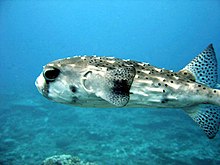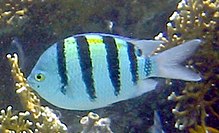Lesseps migration
The lessepsian migration is the exchange of living organisms between the Mediterranean Sea and Red Sea , since the construction of the Suez Canal (opening 1869) under the direction of de Ferdinand Lesseps a connection has been created. It is therefore an invasion biological process; the allochthonous species are considered to be neobiota in their new range .

The construction of the Suez Canal connected two fauna areas . This led to the migration of a wide variety of species from the Red Sea to the Mediterranean; in the opposite direction the migration was much less. The migration is best observed in fish , but other, less conspicuous organisms also spread through the channel.
The fact that the fauna of the eastern Mediterranean in particular has changed is due to the fact that in its climatic conditions and food supply it is more like a tropical, nutrient-poor sea (such as the Red Sea) in many respects , but before the canal was built it was populated almost exclusively from the colder Atlantic has been.
In the various glaciation phases of the last Ice Age , the sea level fell several times around the world by up to 200 meters ( eustatic sea level fluctuation ). During these phases, the Mediterranean was cut off from the Atlantic and shrank sharply. Here died many kinds of. A repopulation in the interim warm phases of the Ice Age was only possible from the Atlantic, but its living environment was not so well adapted to the ecological conditions of the Mediterranean. The Red Sea also shrank sharply several times, but was repopulated by species from the Indian Ocean that were much better adapted to the local environmental conditions . This also explains that the eastern Mediterranean has only about 550 species of fish, compared to about 800 in the Red Sea.
Before the start of the canal construction, there was no precise inventory of the organisms in both seas. It is believed that around 500 species immigrated to the Mediterranean Sea and around 50 species into the Red Sea. The species that found their way into the Mediterranean include, for example, the spiny lobster , which is now commercially caught off the coast of Israel , and the red mullet ( Upeneus vittatus ), known as Sultan Ibrahim , which is of economic importance to Syrian fishermen .
The eight-year lockdown after the 1967 Six-Day War , during which the canal was calm and clear, triggered a significant further surge in migration. Since the spread in the Mediterranean takes place almost exclusively along the coast, the neobiota originally spread mainly to the east and north, because the way to the west was blocked by the brackish water zone in front of the Nile delta . This changed with the construction of the Aswan Dam , which significantly reduced the extent of the brackish water zone.
Examples
Here are some examples of fish species that have spread in the Eastern Mediterranean as a result of Lesseps migration:
- Striped coral catfish ( Plotosus lineatus )
- Fistularia commersonii from the genus of the flute fish
- Red stripe hussar fish ( Sargocentron rubrum )
- Indian lionfish ( Pterois miles )
- Leiognathus klunzingeri
- Upeneus moluccensis
- Upeneus pori
- Indian mackerel ( Rastrelliger kanagurta )
- Red Sea Bannerfish ( Heniochus intermedius )
- Pyramidal boxfish ( Tetrasomus gibbosus )
- Lionfish
Here are some crustaceans :
And the jellyfish species Cassiopea andromeda also spread through the opening of the Suez Canal in the Mediterranean.

